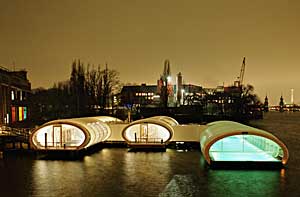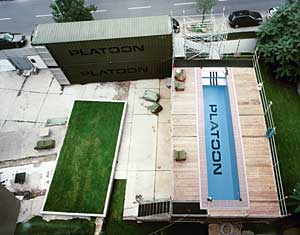Berlin, the capital of Germany, acknowledges the darkest chapters in its history by dispersing Holocaust artifacts amid vestigial Communist buildings and parks. New York City is struggling to remember its own trauma—September 11, 2001—amid new towers and fast-changing neighborhoods downtown. What might these cities say to one another?


The show 'Berlin-New York Dialogues,' at New York City's Center for Architecture, features images of this bridge in Berlin. Wilk-Salinas Architekten with Thomas Freiwald designed this bridge across the Spree River with a swimming pool in a boat whose planes of sight suggest a river dip; every winter since 2005, a temporary roof of elliptical wooden trusses and a double-layered translucent membrane covers the space to allow locals to swim year-round (top). Also featured is a project by architect Hafner/Jimenez, who filled an empty bracket along the old Berlin Wall with a swimming pool and a pedestrian connection to the nearby river; the park is due to open next year (above).
Daniel Libeskind and others broached this subject and elusive principles of memorial design during a panel discussion on Monday evening at the German Consulate in Manhattan. It was part of a festival this fall that seeks to compare the two cities’ cultures. Another event, the exhibition “Berlin-New York Dialogues, Building in Context,” kicks off at 4:30 p.m. today when a 100-person dance troupe will wend its way from Washington Square Park to the AIA New York Chapter’s Center for Architecture.
Images in at the Center portray how German architects have reinvented the Berlin Wall—which began coming down nearly eight years ago to the day, November 9, 1989—as cheery public space without erasing historical marks. This same concept figured in Monday’s symposium. Panelists agreed that urban planners should create memorial spaces that invite people to talk. Libeskind, for instance, linked his Jewish Museum in Berlin to his competition-winning master plan for rebuilding New York’s World Trade Center site. He said that he uses “silence,” signified by voids such as an empty room or the shell of a building, to mark “very difficult” events, maintaining vistas to adjacent neighborhoods to engage visitors who never knew these events.
But sometimes future generations want to banish the past, said HG Merz, a German architect who specializes in adapting historic sites. He showed his update of Sachsenhausen, a Nazi death camp hidden behind suburban houses on Berlin’s outskirts that he turned into a museum. After the Communist regime later recast the gas chamber as a park, Merz converted it to a place whose windowless rooms make museum visitors confront the annihilation. “There is no interpretation here,” he said of the unfathomable space.
The amount of information that a memorial should encode prompted some dispute among panelists. Metropolis editor Susan Szenasy argued that our culture drowns people in computer software, buildings, and commerce that require too much explanation. She urged architects to design simple, traversable monuments that speak for themselves. And Lance Brown, FAIA, the design coordinator at City College of New York and an expert in how cities respond to disasters, said that he had grown weary of governments bickering over how to arrange the names of the deceased on various memorials “for fear that interpretation would take place.” But eventually, he added, the most honorable memorials are the ones that become stages for unscripted future events: “The social spaces that result from memorials are the ones that sustain us.”

Post a comment to this article
Report Abusive Comment